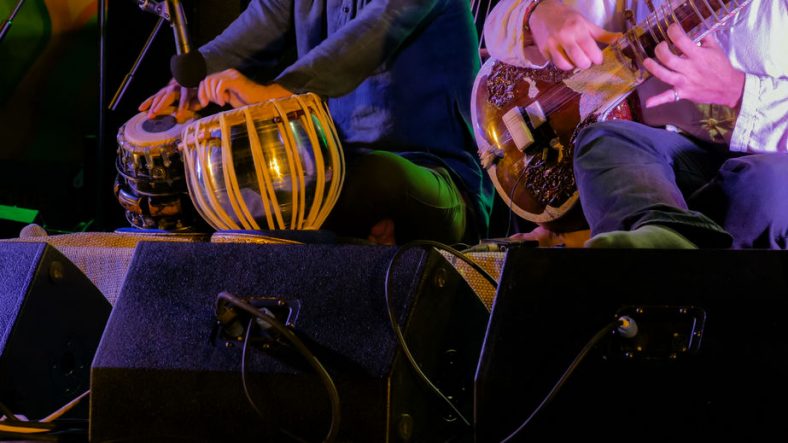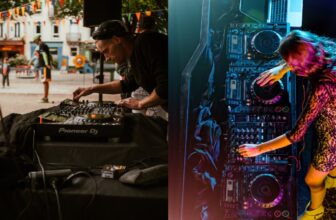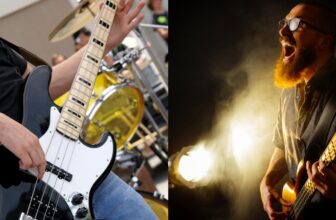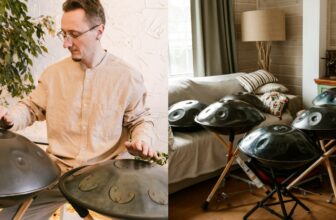10 of the Most Popular Indian Musical Instruments

The spirit of Indian music spans folk genres like Bhangra, and classical traditions like dhrupad, Hindustani classical and Carnatic music.
From khatals and chimtas in the north to the sitar and table in the heartland to the ghatams and mridangam of the south, just trying to cover the percussion instructions of India is challenging.
It is a daunting task to catalog musical instruments from a country like India that possesses a rich heritage of music that spans millennia!
In this article, we’ll cover some of the most widely used Indian musical instruments with a brief introduction to each type.
Contents
1. Tumbi/Ektara – String Instrument
The Tumbi, or toomba, is a has its roots in Punjab, North India. It is a high-pitched single-string instrument that is best known for its role in folk genres like ‘bhangra’ that has gained traction in the West. A tumbi is made from a gourd shell and a wood stick.
It has one paltry metal string attached from the bridge to the tuning peg that is plucked with the finger, often used as accompaniment by a folk singer. You’ve probably heard it in action in the iconic hook of Missy Elliott’s Get Ur Freak On or Punjabi MC’s Mundian Toh Back Ke Rahi.
2. Ravanhatha – Bowed Instrument
The Ravanhatha is said to be the ancestor of the rabab, which is said to be the ancestor of the violin. Without going too deep into the family tree, it is clear that it is a very ancient instrument. This bowed instrument is constructed using a halved coconut shell and a goatskin soundboard attached to a long bamboo neck.
It is strung with 1-4 strings and played with a bow made from horse hair. Today, the ravanhatha is antiquated but you’ll still find some use in musical families of West India, especially Gujarat and Rajasthan. It may not have many superstar players because it is primarily a folk instrument played at festivals and for entertainment.
3. Tabla – Percussion
The table is the most prominent Indian classical percussion that has be used for solo performances and accompaniment. From the tabla-maestro Zakir Hussein to Selena Gomez’s Come and Get It, this instrument can be heard in ad jingles, pop songs, Hollywood soundtracks, and every clichéd depiction of Indians in the Simpsons.
Tabla refers to a pair of hand drums with a single head that are made from teak or Indian rosewood and topped with a thin goatskin head. They are a mainstay in folk, pop, Bollywood, and every imaginable ensemble in India. They follow a complicated rhythmic/metrical system called tala that is based on the ‘bol’ and matras (beats).
4. Dhol – Percussion
A dhol is arguably the most widely used Indian percussion that has multiple regional variations. It is a double-sided percussion barrel played with two sticks or mallets made from cane or bamboo.
One end is played with a thick stick called dagga (like a drum kick), while the other side is played with a thin stick called tihli to get high notes (like a drum snare).
Based on its use and the regional preference, the barrel can be made from fiberglass, plastic or steel.
The skin and size can vary, but animal hide and synthetic skins are the commonly used materials for drum heads. The larger the dhol, the more bass/punch you can expect from it.
5. Pakhavaj – Percussion
While many know of the table percussions, the Pakhavaj is considered to be its predecessor. They two instruments shares aesthetics and playing technique, but the pakhavaj consists of one double-barrel drum and is more exclusively used in North Indian devotional (dhrupad) music.
The two-headed drum is often used for accompaniment for music, song, and dance performances. The left, bass face, is struck with the whole palm for a deep sound and the right side, the treble face, is used to play rhythm. Like the tabla, the pahavaj also is has a bol system of mnemonics designed for recital and playing.
6. Sitar – String Instrument
Sitar, the plucked string instrument, is among the most popular Indian instruments known in the West.
It has been featured in various hits like Elton John’s Holiday Inn, Paint it, Black by The Rolling Stones and various tracks in Norweigian Wood, the iconic album by The Beatles.
It features a large gourd with a longed neck that houses 20 frets to play metal strings with 13 symapthetic strings that are tuned to the notes of a raga. It originated in India during the 16th century and has become one of the most popular instruments in Bolywood and Indian classical music.
7. Sarod – Fretless String Instrument
The Sarod is principally a lute-like Hindistani classical instrument, predominant in the north and western parts of India. It is a fretless instrument with a drum-like body, a neck, and an extra bridge for drone strings. It sounds like the sitar but has a deeper and more pensive tone that can be highly evocative for playing morning ragas.
A sarod has many variations but it is mainly available in a 6-string and 8-string version. The strings are tuned to a raga and musicians use the finger nails (not finger tips) of their fretting hand to play glissandi while the plucking hand uses a coconut shell plectrum called jawa. Ustand Amjad Ali Khan, Ali Akbar Khan, Buddhadeo Dasgupta, and many others.
8. Esraj – Bowed Instrument
The Esraj is one of the youngest Indian string instrument that is roughly 300 years old. It is often called the modern version of a Dilruba, another ancient Indian instrument. It has a gourd (body) with a goatskin soundboard and a long sitar-like neck.
The neck sports 20 metal frets with playing strings and 12 to 15 sympathetic strings. The instrument is played with a box called a ‘gaz’. Pandit Buddhadev Das, Ravi Shankar, and S. N. Bose are some well-known Esraj players. It has also been used in George Harrisons’ solo work, most notably the song Within You Without You.
9. Santoor – Hammered String Instrument
A Santoor is a zither-like instrument that is incredibly complex to make and to master musically. It’s origins can be traced back to Ayurveda, the traditional medicinal system, that advocates it as for ‘healing music’ that can revitalize and anchor those who encounter disturbances of the mind and body.
The traditional santoor is made from walnut or maple wood with 100 strings spanning 25 bridges i.e. 4 strings per bridge. It is a hammer instrument that is popular in classical and folk music of North India, especially Jammu and Kashmir. Pandit Shivkumar Sharma and his son Rahul Sharma are notable current-day Santoor virtuosos.
10. Rabab or Rubab
The Rabab is belived to have originated in Central Asia (Afghanistan) but made its way to India with the Sufi poets in the 14th and 15th century. It is common used in the music of Kashmir and the Sikhs. This plucked instrument sports a long neck with 2 strings made from animal gut that are of equal gauge.
Raba players use a bone or coconut shell plectrum to create rhythmic patterns, usually fast-paced, using the two and a half octaves of range. Historians believe that the rabab became the rebec as it reached Europe and eventually evolved into the violin. The late Sonaullah Bhat is considered to be one of the most iconic musicians in the Kashmiri Rabab gharana (tradtition).
Summary
As you may have noticed, traditional Indian music instruments are usually melody-based and play solo with or without percussion accompaniment. The classical music tradition doesn’t have any harmony i.e. no instruments play chords.
These are just a handful of a much larger body of really fascinating and unique group of instruments that vary tremendously. We’ll cover some of the center-stage instruments used in carnatic music (of South India) in out next part.





